While walking around the Chichén Itzá site that belongs to the civilisation of the ancient Mayas, infallibly I came to a spacious clearing where the Observatory (Observatorio) is located. This is a circular structure placed on a large square platform. The Observatory is also called El Caracol, which means “the snail,” because there is a spiral staircase within the structure.
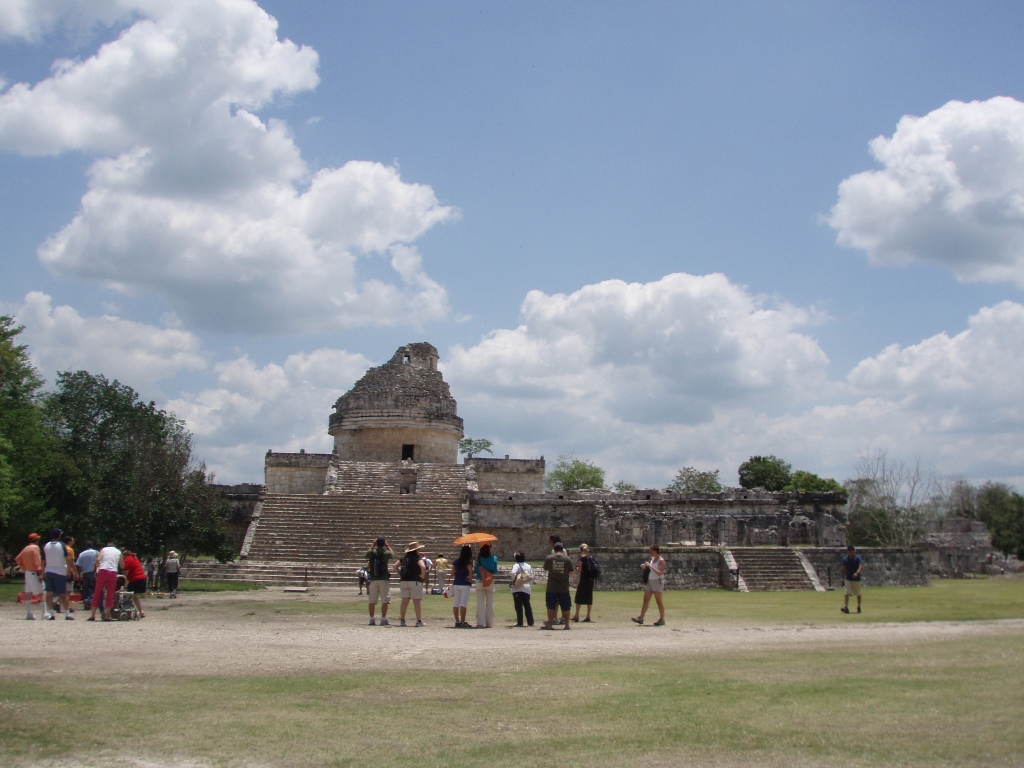 El Caracol
El Caracol
On the one hand, this structure shows that the Mayas were skilful in the construction of round structures, i.e., the structures with a circular ground plan, while on the other hand the windows-openings that exist on this building were all linked to the positions of the key celestial bodies on the specific dates that were significant according to the Maya calendar.
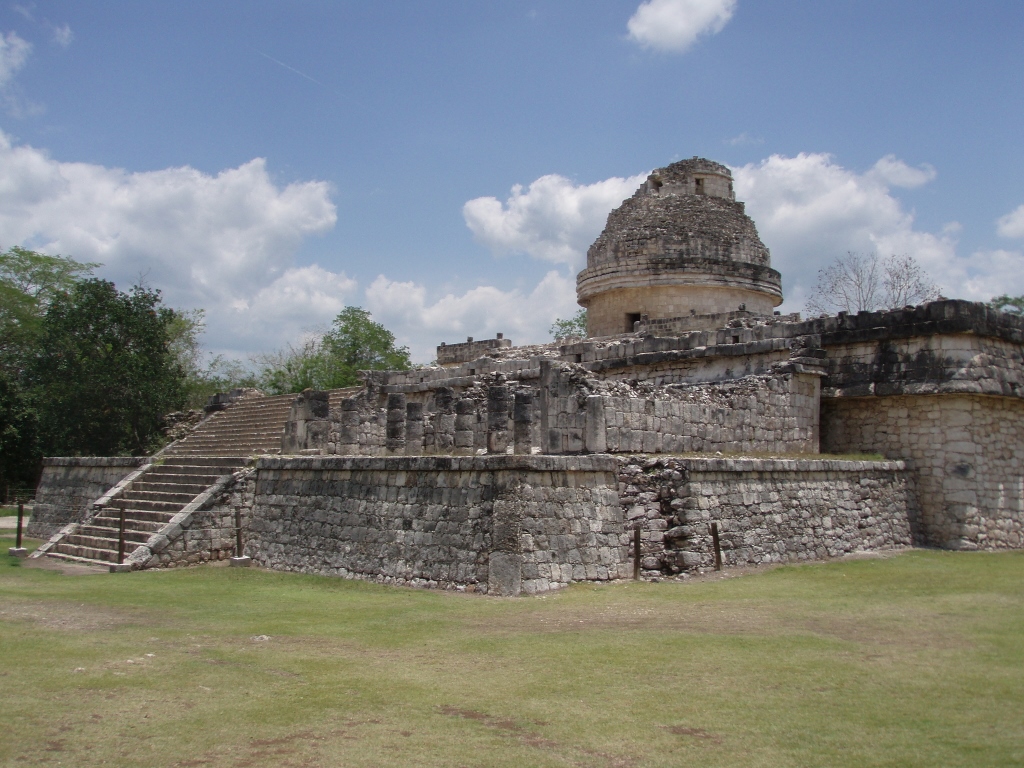 El Caracol
El Caracol
I think that even those who don’t know how to find the cardinal directions have heard of that famous Maya calendar. The human race is very prone to the influences of marketing and EVERYTHING can be advertised and sold. Including also the story about the overall cataclysm around 21 December 2012 when the Maya calendar was apparently ending, which was interpreted by the apocalypse-inclined individuals as the end of the times. Those, however, who like to think positive thought on their side that this would mark the beginning of a new era (judging by the events around the globe, at least for the time being, the Age of Aquarius has not been creating a sufficiently positive framework, so let’s add in some Mayas; nothing wrong with the excess of rose-coloured glasses). And yet, at this time, I can completely reliably claim that the day came and went away without any major event.
The Mayas were certainly very good astronomers, among the best in the world before the invention of a telescope, but their astronomy was primarily focused on the ceremonial purposes and the farming cycles. In other words, on the local religion and agriculture. In those terms, their calendar was very precise, but obviously it did not deal with the question of apocalypse. After all, since the calendar was certainly created and its elements were calculated by individuals of high positions (presumably the priests), if they had known to foresee a cataclysm, they would have probably dealt with the end to the Maya civilisation and the demise of their own world, rather than whether something unpleasant is going to happen on the planet Earth some thousand years later.
Still, in terms of mathematics and astronomy, the Mayas were fantastic and they even had the concept of a zero, relatively well before the Indians who in their part of the world transferred it to the Arabs, who then transferred it to Europe with the rest of the numbers (since the Roman numerals, as the predecessor of the Arabic numerals, were practically unusable for mathematics). On the other hand, the zero used by the Mayas did not have any impact on the Old World, since by the time the Spanish came here they had been already using the zero, while the Maya civilisation was taking its dying breaths.
It also needs to be mentioned that the Maya as a people have certainly not died out, their descendents are nowadays the citizens of Mexico, Guatemala, etc., but their civilisation in terms of developed culture, architecture, religion and the ruling dynasties is long gone.
The next thing I visited within the archaeological site of Chichén Itzá was the group Las Monjas, meaning the Nuns or the Nunnery. It was again the Spanish who gave this name, but this in fact used to be a palace, although the researchers cannot agree about who it may have belonged to.
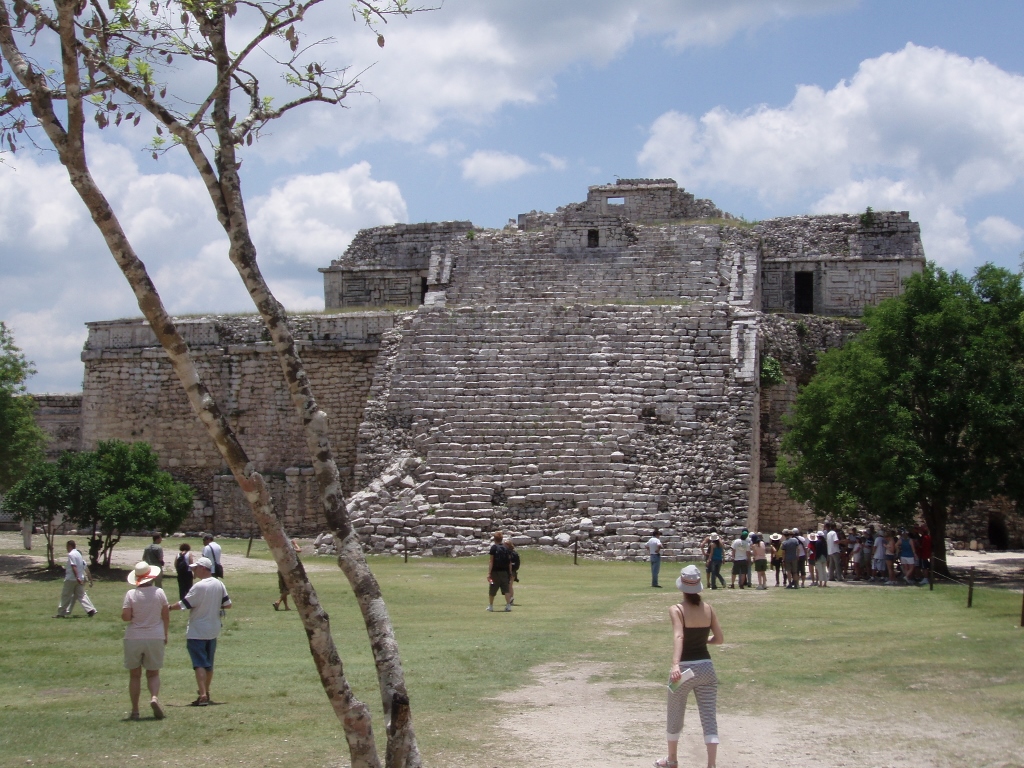 Las Monjas
Las Monjas
By the way, the Las Monjas structure belonging to the Old Chichén Itza area was built in the Puuc architectural style. Among other things, this style is characterised by richly decorated facades, especially the friezes as the decorative ribbons. A section of this may be seen in the upper right-hand corner of Las Monjas.
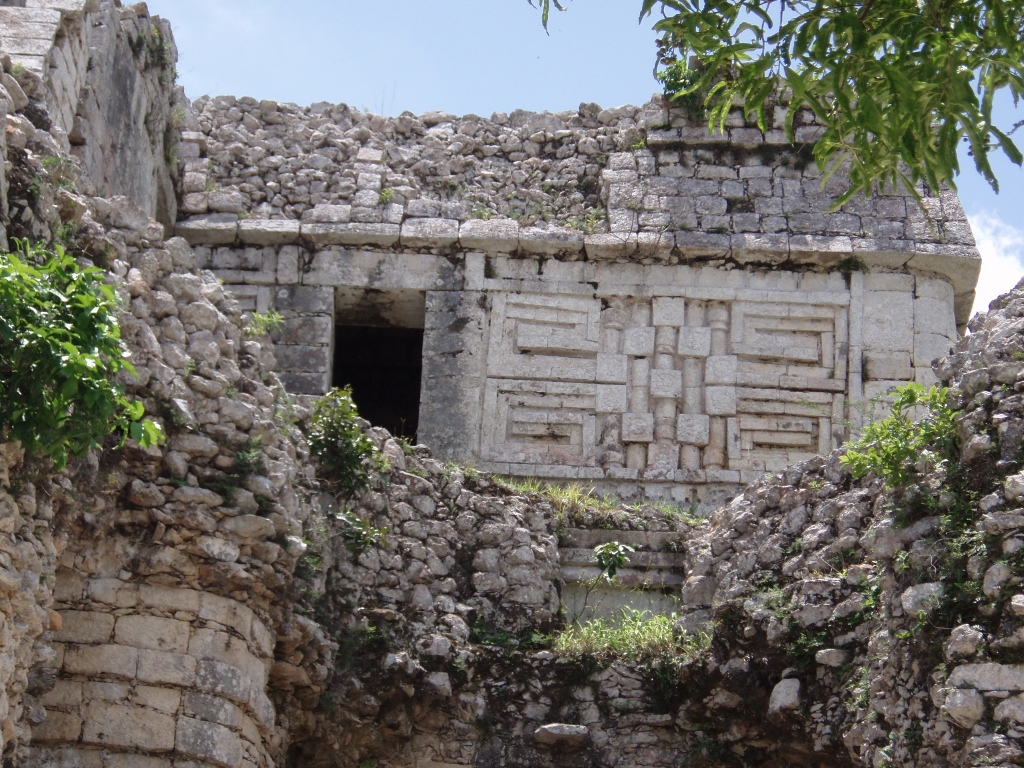 Las Monjas, a detail
Las Monjas, a detail
The reason why the Spanish called this structure as they did lies in the fact that the rooms that are located on the ground floor of this structure are so small that they reminded the Spaniards of the small cells in a nunnery. This ground floor wing extends to the left of the massive section with a stairway that is first seen when one approaches and it practically constitutes an annex of the palace. As it may be seen in the following photo, it was not possible to enter there.
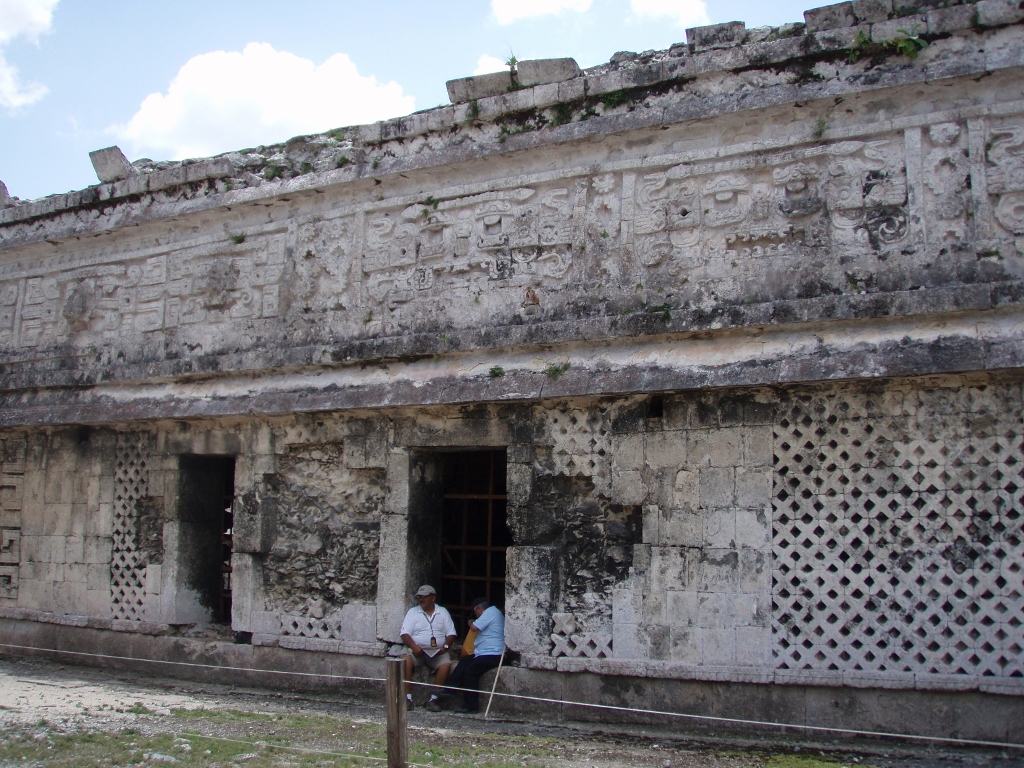 Las Monjas, a part with the rooms in the ground floor wing
Las Monjas, a part with the rooms in the ground floor wing
In the photo above, it is also possible to see the opulence of the wall decoration and this can also be seen well on the lateral side of this ground-floor section of the building, which is famous for the lavishness of its stone decoration.
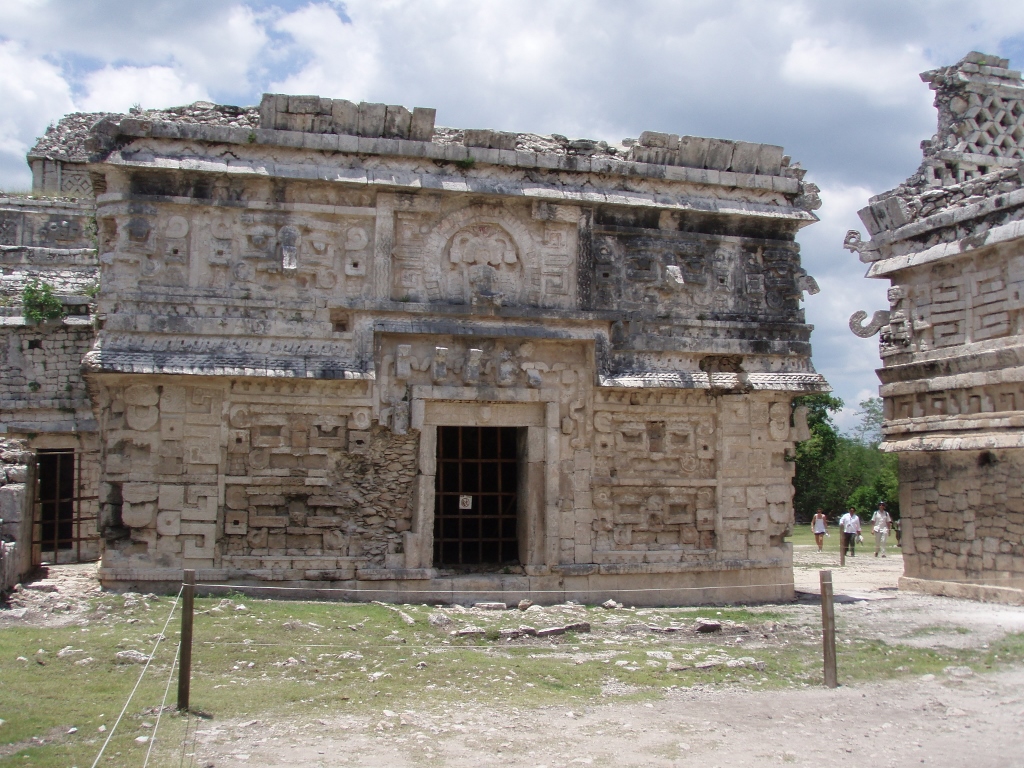 Las Monjas, the lateral side of the ground-floor section
Las Monjas, the lateral side of the ground-floor section
In the photo above, on the right-hand side, it is possible to see a part of yet another well-known structure. This is La Iglesia, which means “the Church.” Of course, this is not a proper church, but where there’s a nunnery, there’s a church and after all this is indeed a small temple.
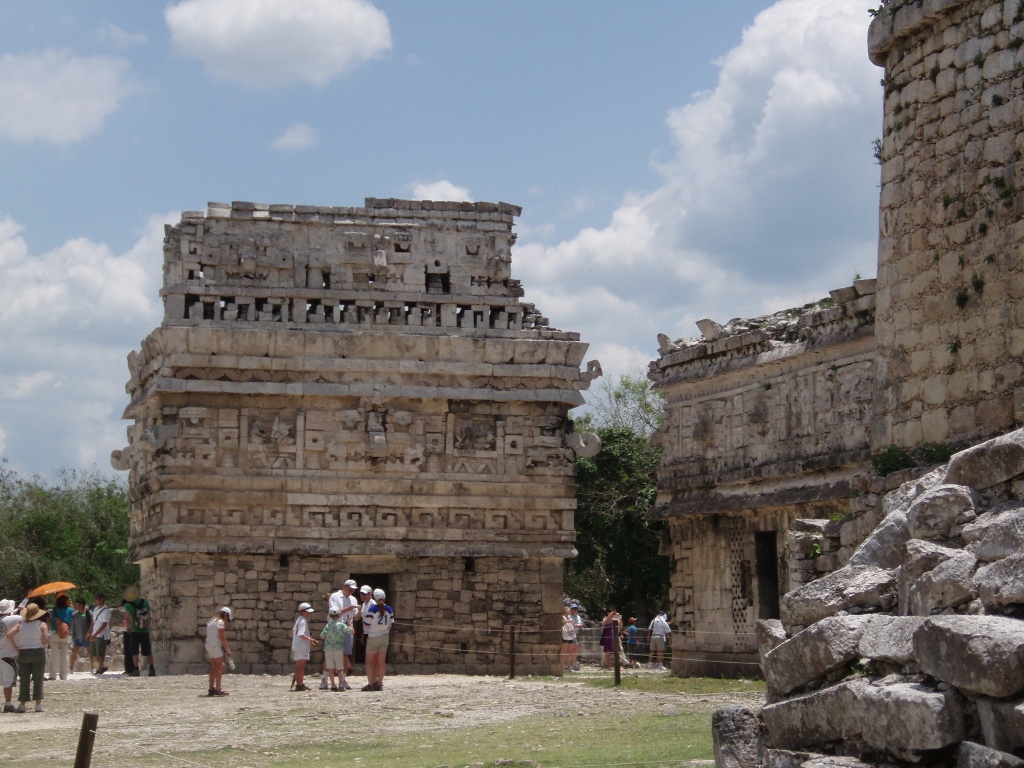 La Iglesia, view from the front; to the right are parts of Las Monjas
La Iglesia, view from the front; to the right are parts of Las Monjas
La Iglesia is significantly smaller than Las Monjas and it consists of a single room only. It is also richly decorated on all sides.
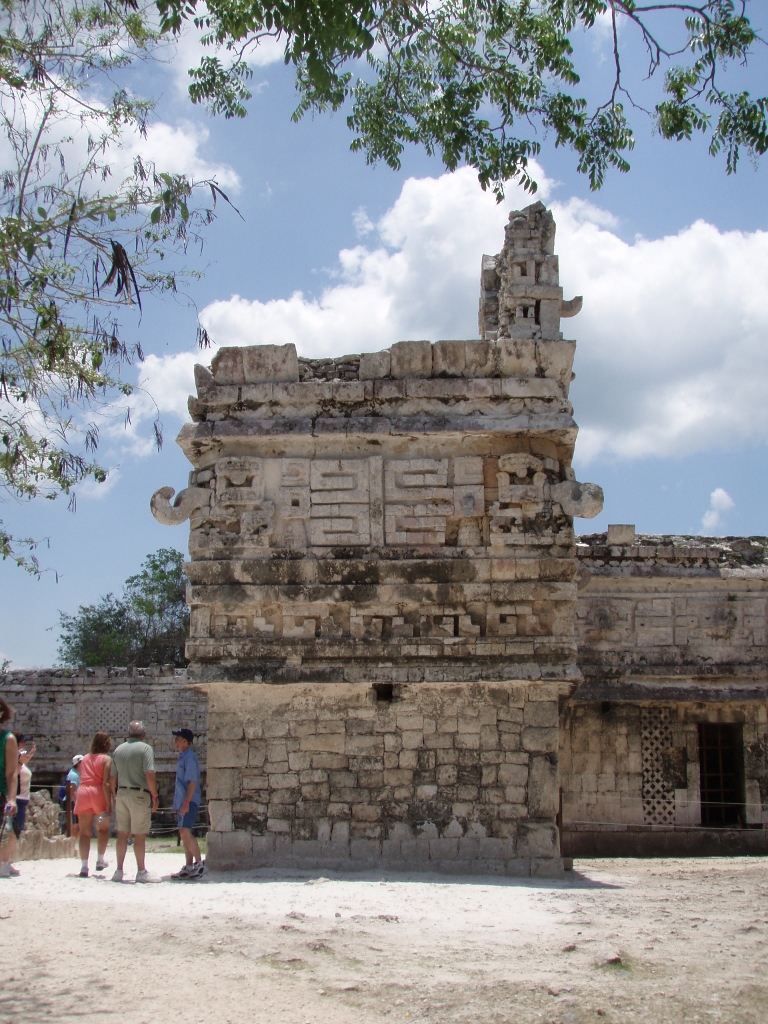 La Iglesia, side view; in the background are parts of Las Monjas
La Iglesia, side view; in the background are parts of Las Monjas
Like a frieze, in the upper section of La Iglesia there is a decorative zone that extends along the entire perimeter of the structure. This zone is dominated by the masks of god Chaac positioned on all of the corners, as well as in the middle of the front and the back sides.
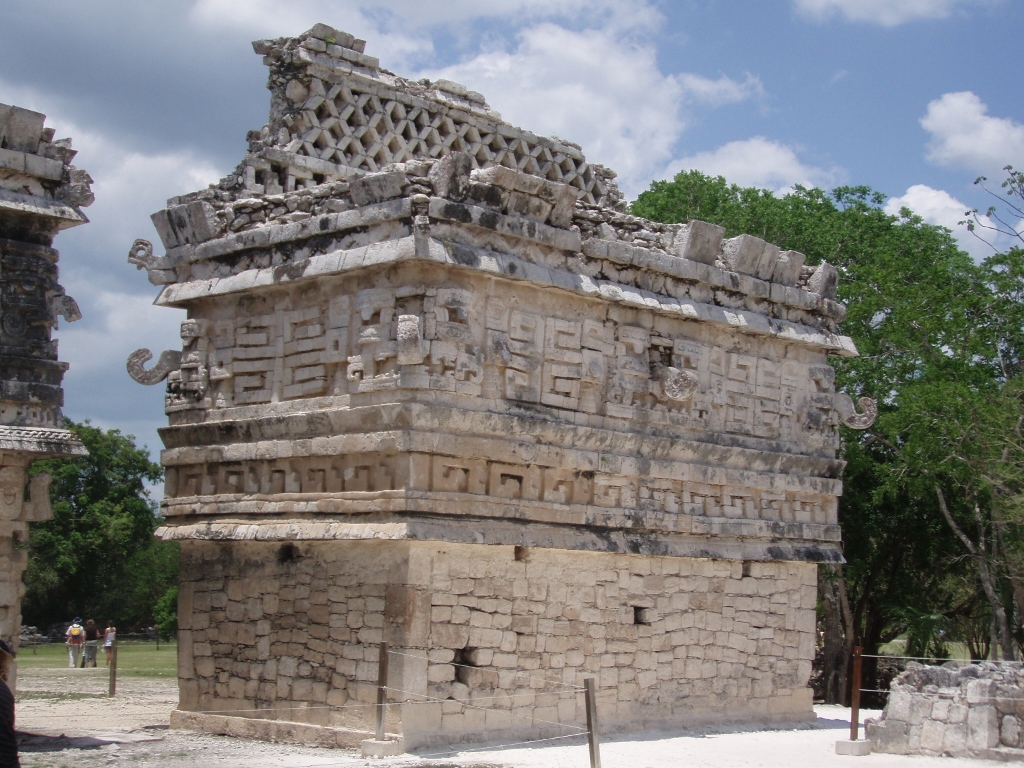 La Iglesia, a lateral and the back sides of the structure
La Iglesia, a lateral and the back sides of the structure
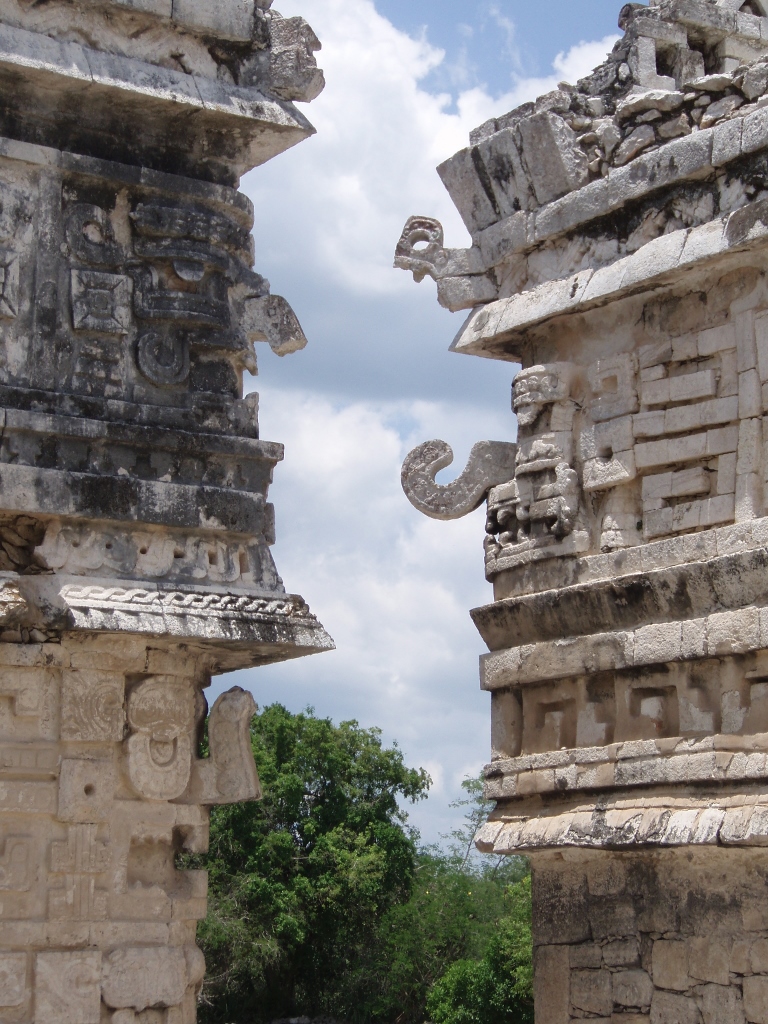 Las Monjas and La Iglesia, details of the decoration on the corners of the buildings
Las Monjas and La Iglesia, details of the decoration on the corners of the buildings
Although it was noon and it was hot, there were a lot of visitors in Chichén Itzá on this day. On the other hand, the site is quite spacious and different structures are scattered across a larger area, so from time to time, like for instance when I was in this part of the site, it could happen that there were almost no people in sight, as it may be seen in a couple of photos above.
Nearby, there are a couple of other structures, the Akab Dzib (Akabdzib) and the Temple of the Wall Panels (Templo de los Retablos), but I just passed by them more or less, since there were many other places I wanted to see and thus I started slowly to return towards the central section of the site.
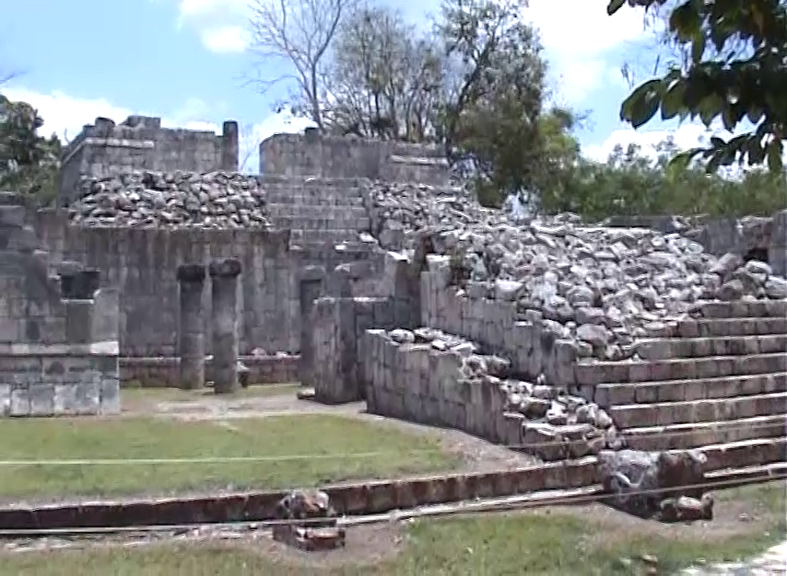 Temple of the Wall Panels
Temple of the Wall Panels
Still, since I’m already showing a photo of the Temple of the Wall Panels, let me emphasise once more that the names of the structures do not originate with the Maya, but rather they were given either by the Spanish or by the researchers. Thus, this temple got its name after the reliefs on its north and south walls and what is interesting is that the temple on the top was reached by going up a stairway, then across a large platform built over the pillars that can still be seen today. The research has shown that the offerings of the human sacrifices here were linked to fire.
Going back towards the central part of the site, I also passed by several smaller and less important structures. It needs to be said that within the site there are several of the more important and larger structures, but also a myriad of smaller ones. The point is that this reflects the size and the diversity of the structures built in Chichén Itzá. It is believed that at the pinnacle, the city had around 35,000 inhabitants.
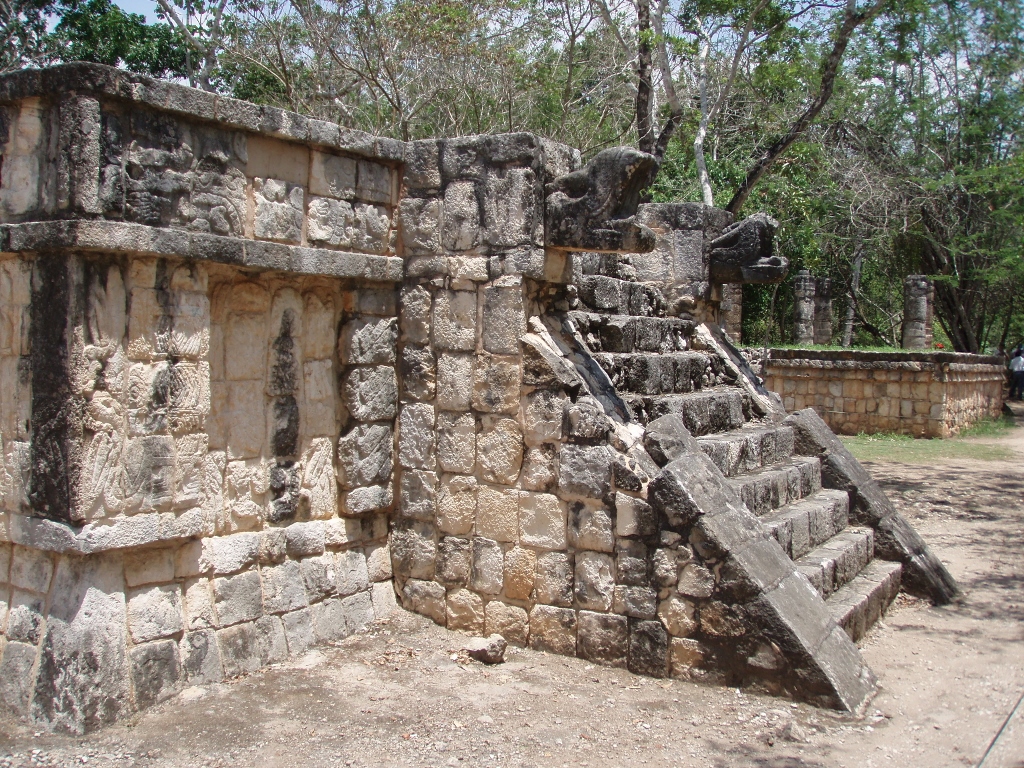 A less important structure in Chichén Itzá
A less important structure in Chichén Itzá
In the spring of 2008 this was quite a lively place – there were numerous visitors, as well as a large number of probably Maya descendents who now live from selling souvenirs. Chichén Itzá is one of the most frequented archaeological sites in Mexico.
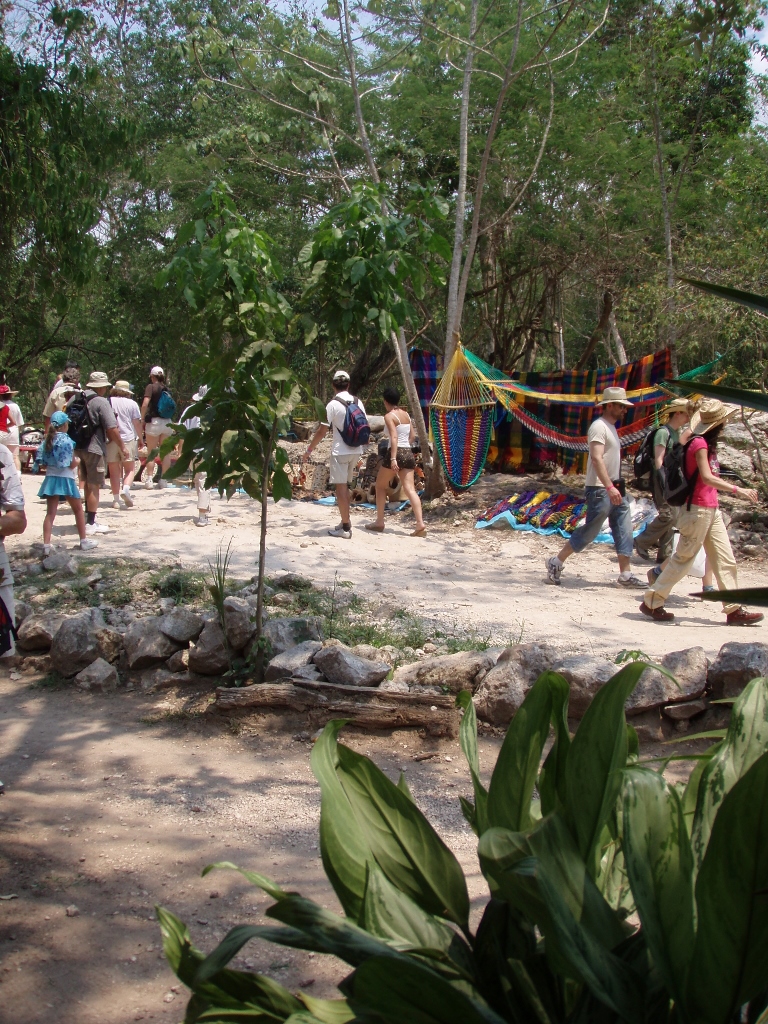 Typical path in Chichén Itzá
Typical path in Chichén Itzá
As it can be seen in the photos, this was a sunny day with a cloud here and there, but it was very hot. Admittedly, there was a lot of shade on the site coming from the numerous trees, plus, there was a nice breeze from time to time which cooled one a little, so it was not unbearable, but by this time I was quite tired with all the walking in the heat.
So, I stopped at something that was a souvenir shop, as well as a refreshment shop and I bought a cold beverage there. The entire structure was built on top of a not too high platform and so I sat on the platform a little to the side where there were also some large clay pots, quite suitable for me to put my feet up on them and relax. As it was very hot, it was not enough only for me to sit in the shade and sip a cold drink, so at first I also had to cool myself with a fan. With time, the temperature of my body got stabilised and that break certainly felt good. While I was sitting there I chatted with some Mexicans and they spoke to me about the site of Palenque that I was planning to visit in a few days.
After this nice break, I continued with my sightseeing and so I got to the Group of a Thousand Columns (Grupo de las Mil Columnas). As the name suggests, this is a group of structures with a large number of columns. Most of them are the structures that are like long platforms with those columns, but there are columns also within the Temple of the Warriors (Templo de los Guerreros) that is practically adjacent to the Group of a Thousand Columns.
Initially I started with the sightseeing from the back side of one of those platforms that I came across first.
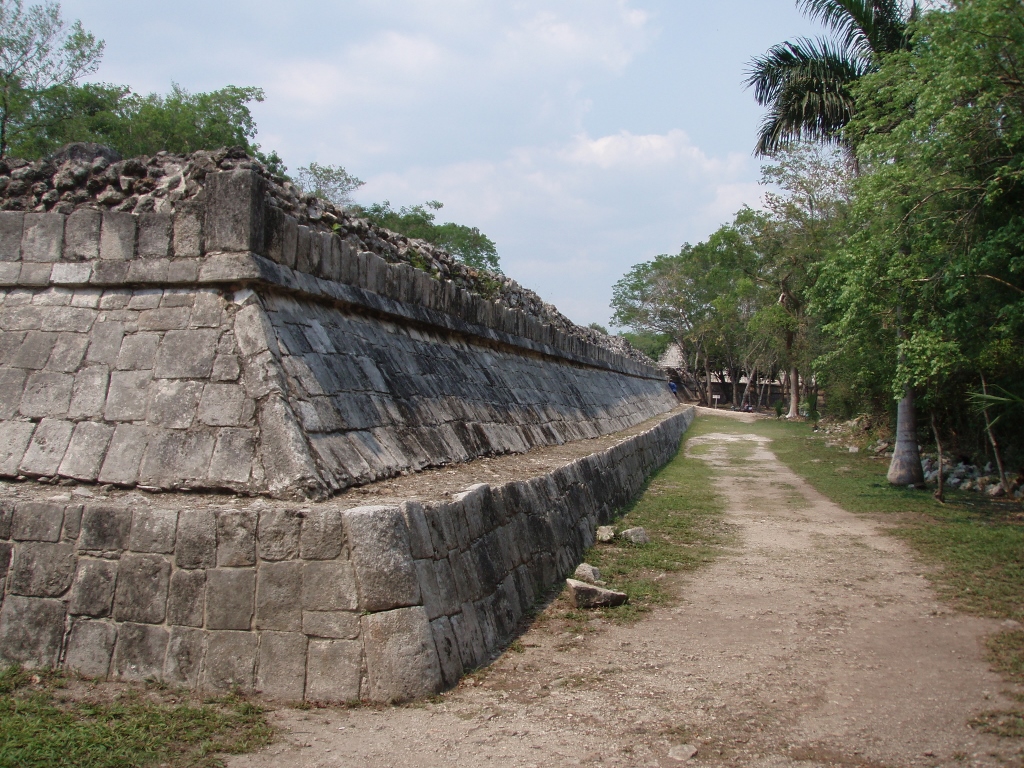 A part of the Group of a Thousand Columns
A part of the Group of a Thousand Columns
The path that can be seen in the photo above leads in the direction of the Temple of the Warriors, but at some point the wall on the left-hand side of the photo has an open passage and I headed there in order to go to the front side of the structure that was filled with columns and that faced the central pyramid, El Castillo.
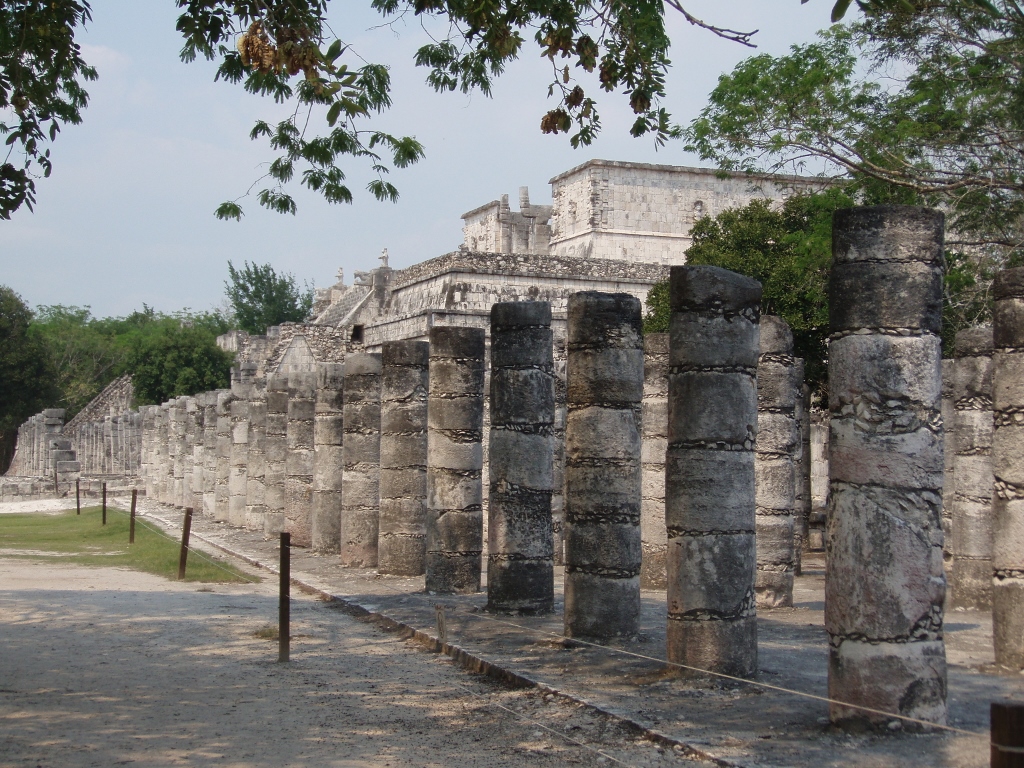 Group of a Thousand Columns; the top of the Temple of the Warriors is in the background
Group of a Thousand Columns; the top of the Temple of the Warriors is in the background
Still, I first went back in order to see other parts of the Group of a Thousand Columns that are located around a clearing called the Square of a Thousand Columns (Plaza de las Mil Columnas).
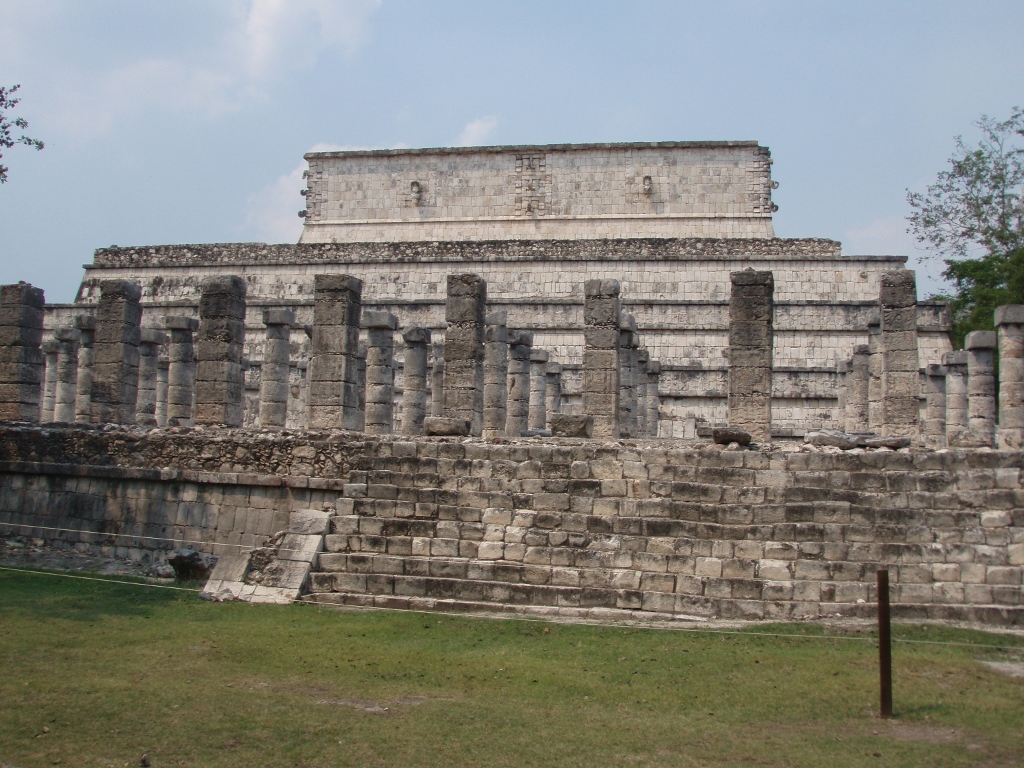 Group of a Thousand Columns; the flank of the Temple of the Warriors is in the background
Group of a Thousand Columns; the flank of the Temple of the Warriors is in the background
There are many interesting details there, but my eye was caught by a wall that is a proper proof of where the Noughts and Crosses game comes from.
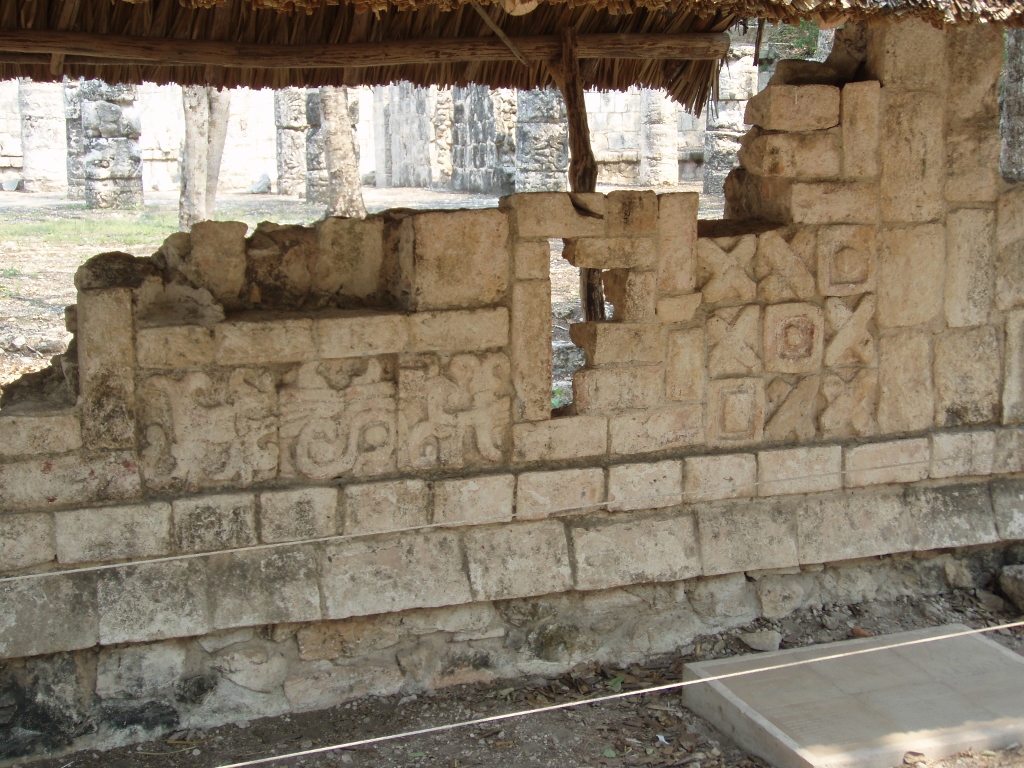 Noughts and Crosses, the Maya way
Noughts and Crosses, the Maya way
Joking aside, there are several structures in this section that all have lots of columns. For instance, the Palace of the Carved Columns (El Palacio de las Columnas Esculpidas).
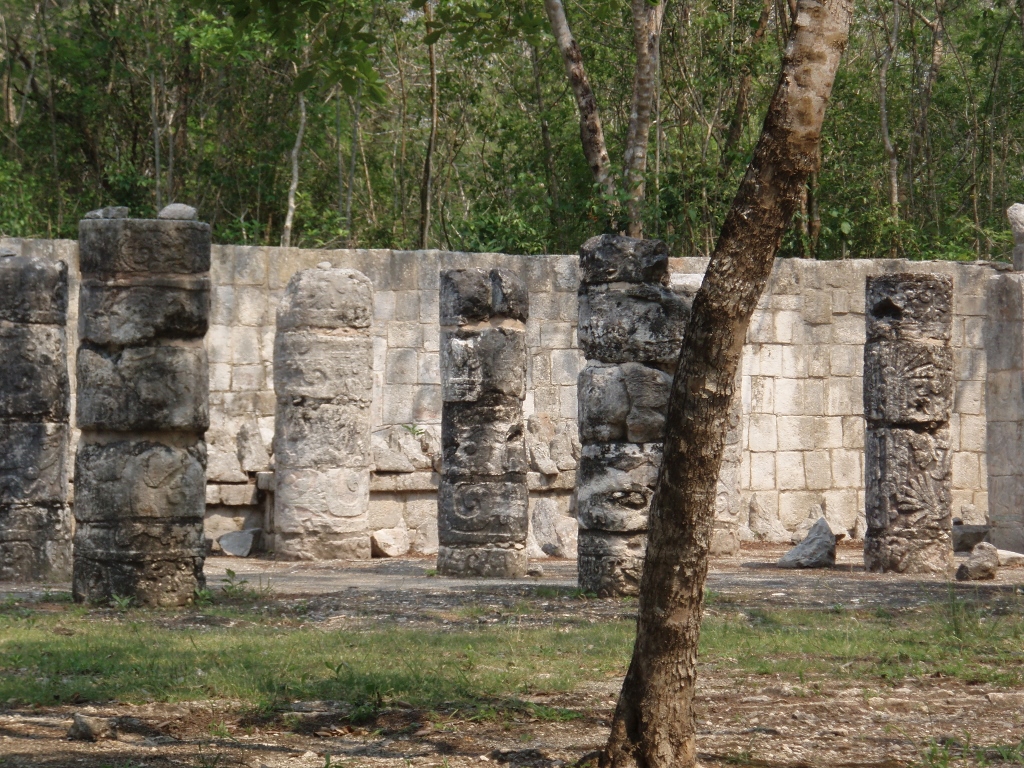 Palace of the Carved Columns
Palace of the Carved Columns
And there is also the Market (El Mercado) where I entered. This name has been given probably because the structure reminds of Roman markets with an atrium in the middle. What is presumed is that the structure used to be very important since it was linked to the Square of a Thousand Columns that is in front of it. The roof was most likely made of timber and not of stone. On the other hand, it is almost certain that the building was not used as a market, but rather like all other buildings in this group it used to have a ceremonial function.
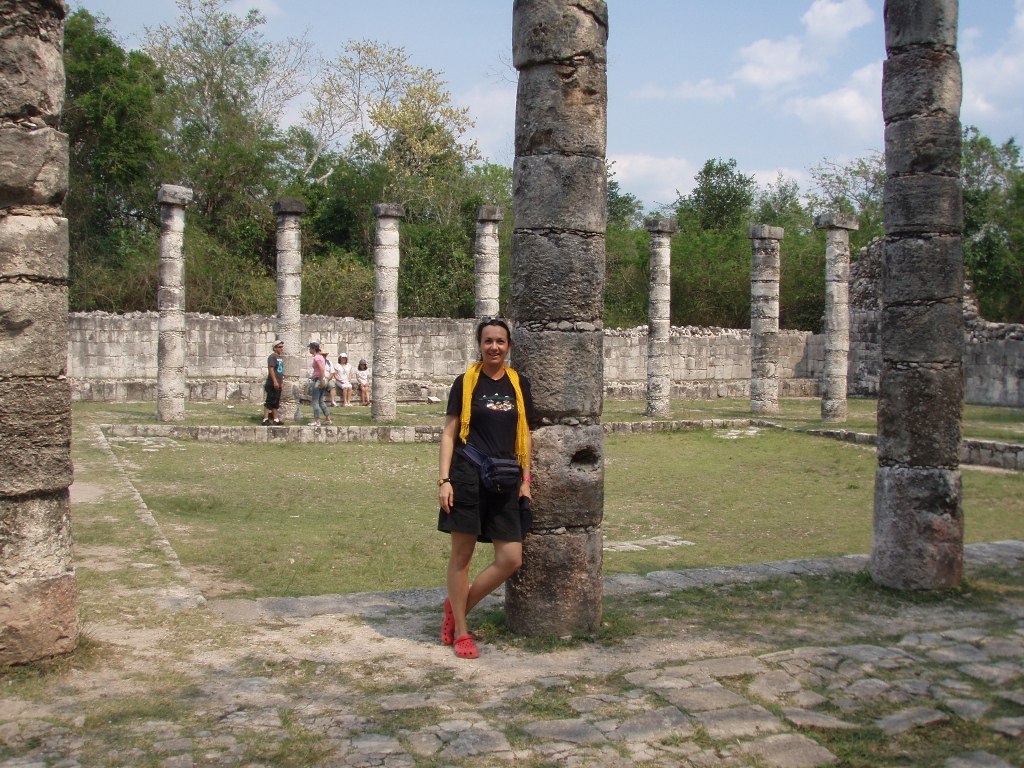 The Market
The Market
As it may be seen in the photo, I was sightseeing around Chichén Itzá in all of the heat with a yellow scarf around my neck. I mostly kept it wrapped around, for I had bought it the day before since the skin on my neck was sunburned and so it had to work as a mechanical protection. This mostly functioned well, but from time to time I had to unwrap it, like when I posed for the photo above, since I wanted to faint with the heat.
Close by there was also a less important structure, but I happened to be there when there was a group of tourists with their guide. He was explaining some details to them and I simply happened to overhear it while taking photos. This was all about the Steam Bath (Baño de Vapor).
In addition to the whole story about the steam bath among the Maya, it was particularly interesting that this was the place where one could nicely and clearly see an architecturally “false arch” (a corbelled arch), although this was in fact more of a vault, but the principle is the same.
The Maya may have been masters of astrology, but as far as architecture is concerned they did have some shortcomings and thus they did not know how to make a proper arch/vault. On the other hand, they were skilful enough to make the semblance of a proper vault by starting to build two parallel walls sloping one towards the other and then somewhere at the top of the “vault” they would join them together by a stone slab. What one gets is a vault effect, without being a proper vault. Still, lest I appeared as too critical of the Maya, this type of arch/vault did appear in other parts of the world and in different epochs.
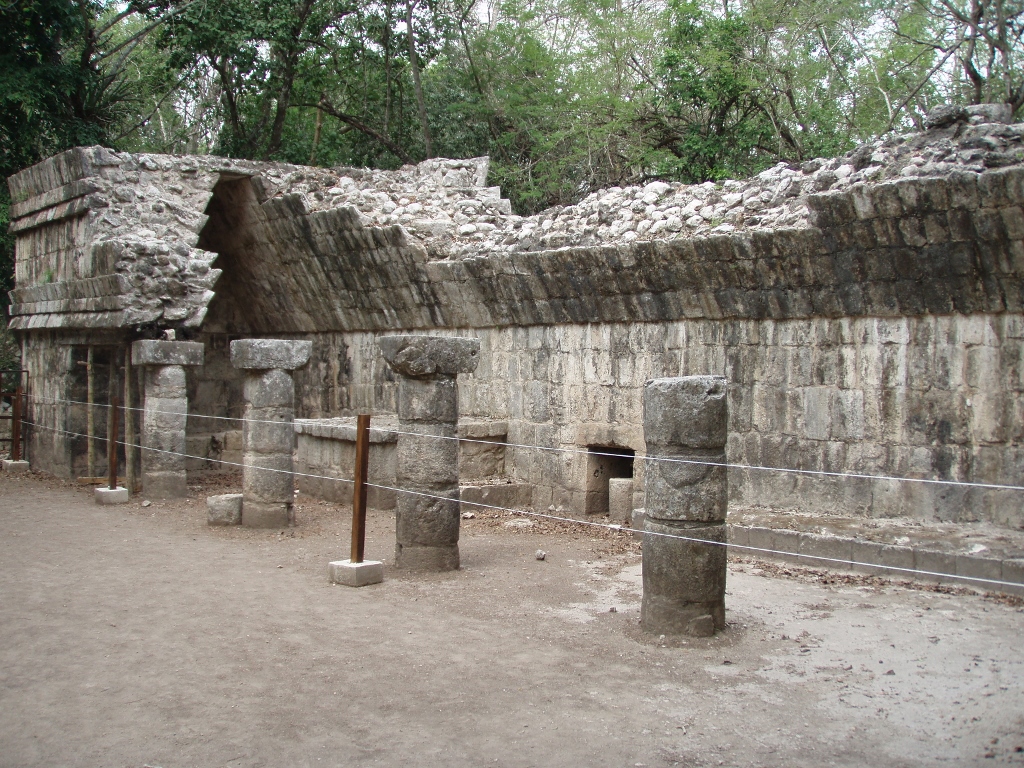 Steam Bath, the remains of a Mayan arch may be seen to the left
Steam Bath, the remains of a Mayan arch may be seen to the left
After this I returned to the clearing close to the big pyramid, El Castillo, in order to have a better look at the Temple of the Warriors from the front side. Along the way, I came across some of the numerous local souvenir vendors.
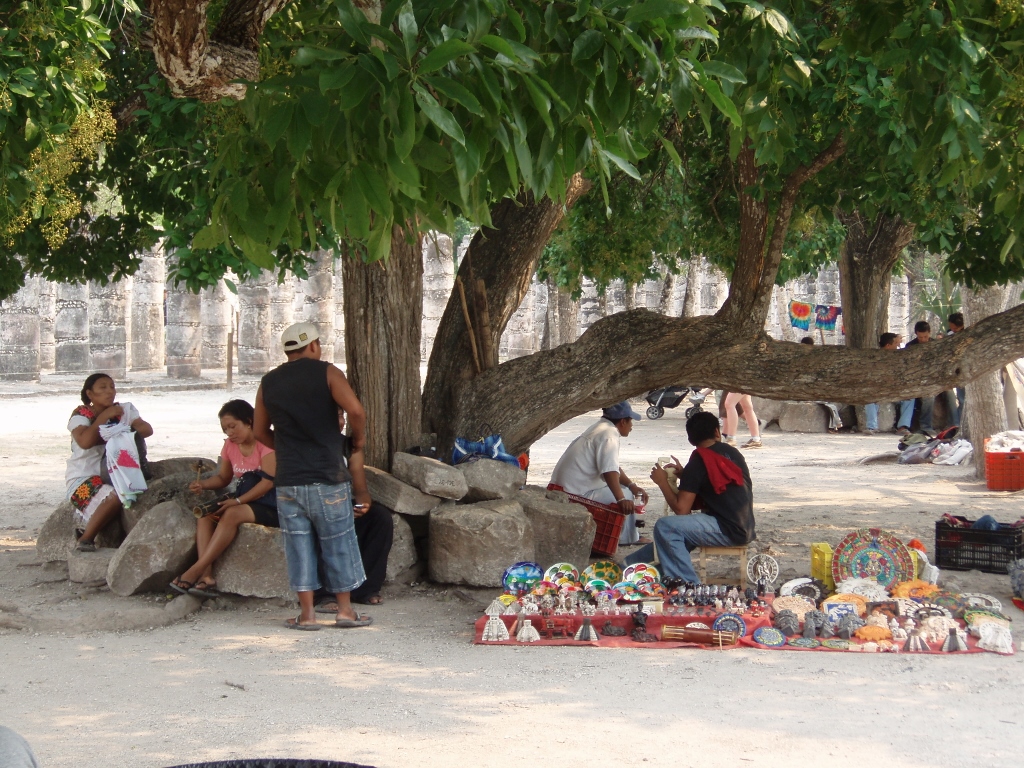 Souvenir vendors also prefer the shade
Souvenir vendors also prefer the shade
The Temple of the Warriors was built on the top of a lower, but extended step pyramid in front of which there is a zone filled with columns. It is presumed that it was dedicated to the rain god Chaac.
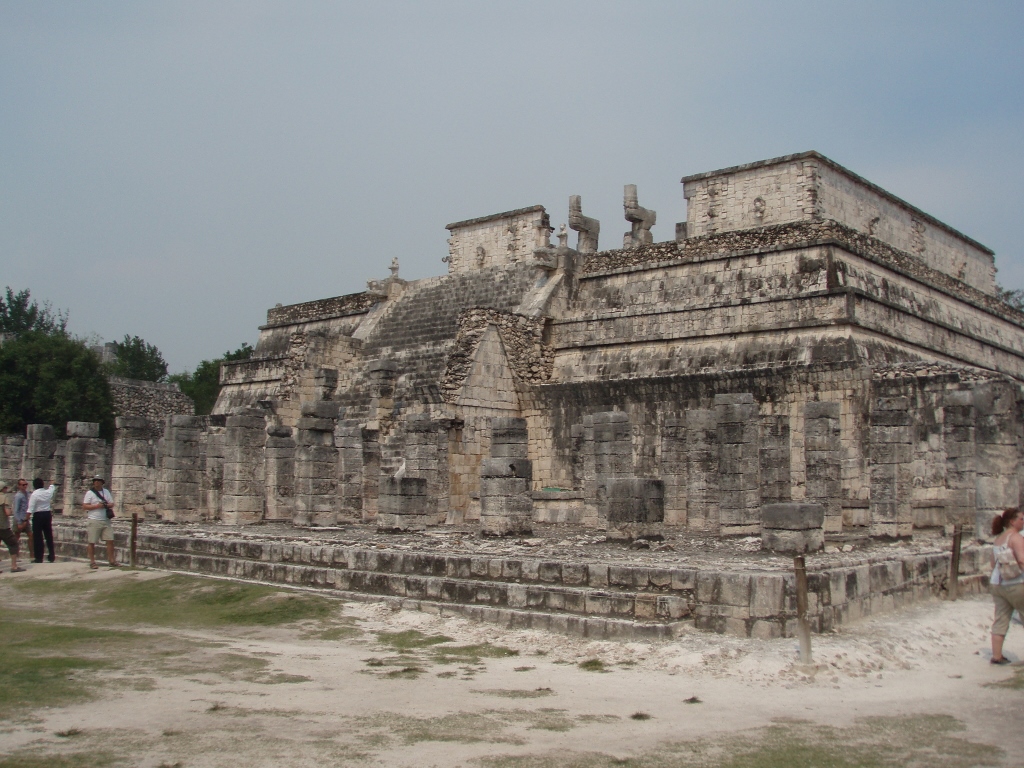 Temple of the Warriors
Temple of the Warriors
It is no longer permitted to climb to the temple, but up there, in front of the temple itself, there is the statue of Chacmool. This is a figure that faces the approach sideways and that is in the reclining position, but resting on its elbows, with the legs bent and with the head turned towards the approach path, while the part of the figure where the stomach is was used in order to place a bowl with the offerings to gods there. The only thing that can be seen from the ground, as far as the entrance into the temple is concerned, are the tops of two columns that have an angular ending, for these parts actually show the tails of two feathered serpents the heads of which are on the ground of the upper floor, right behind Chacmool, so they cannot be seen from the ground.
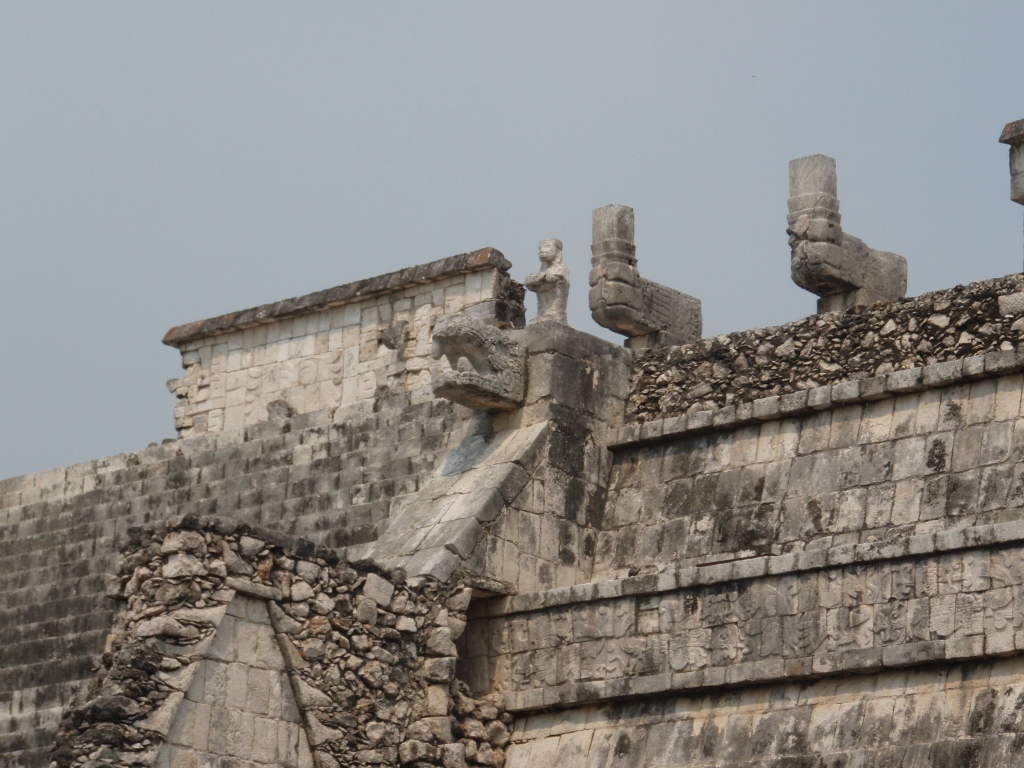 Temple of the Warriors, a detail
Temple of the Warriors, a detail
What can be seen from the ground are numerous details and decorations on the front side of the temple where it is possible to see the unavoidable rain god Chaac and the feathered serpent Kukulkan that has the head of a warrior coming out from the agape maw.
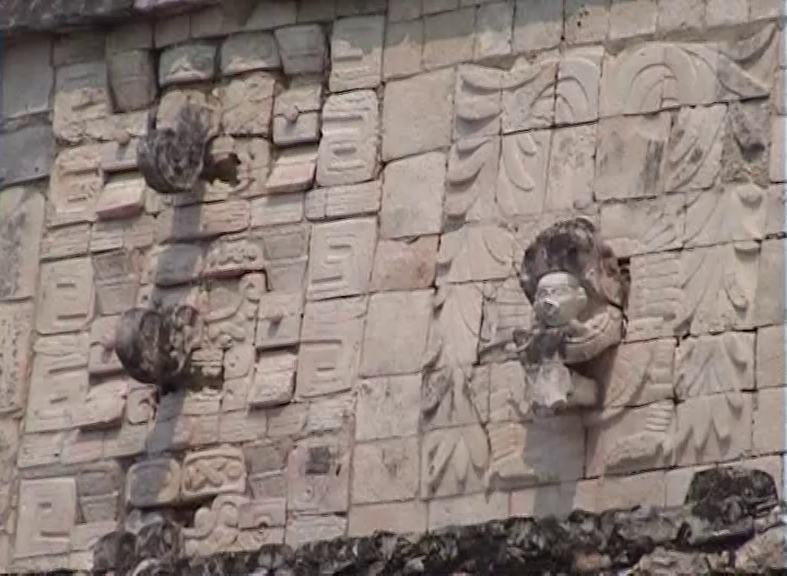 Temple of the Warriors, a detail from the front facade: the masks of god Chaac are to the left, while Kukulkan is to the right
Temple of the Warriors, a detail from the front facade: the masks of god Chaac are to the left, while Kukulkan is to the right
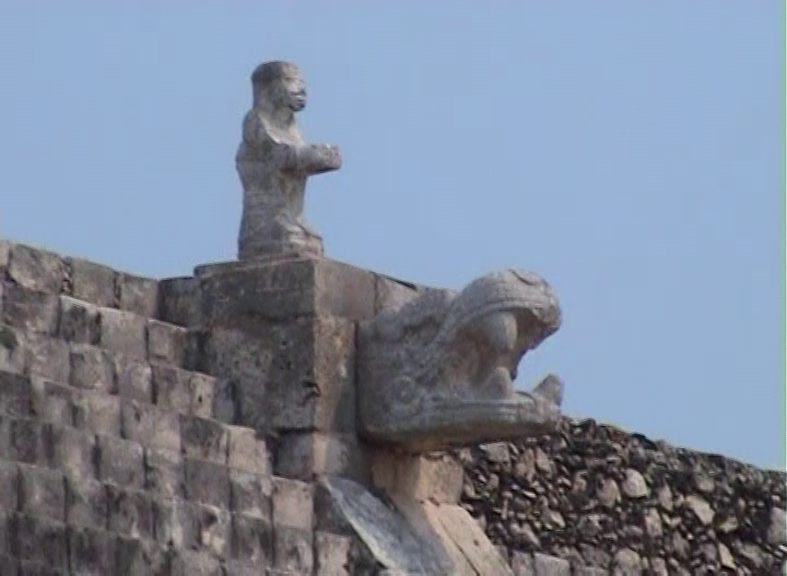 Temple of the Warriors, a detail from the top of the stairway
Temple of the Warriors, a detail from the top of the stairway
As I’ve said, in front of the stairway leading to the top of the pyramid there is a section with columns and some of them are very nicely carved.
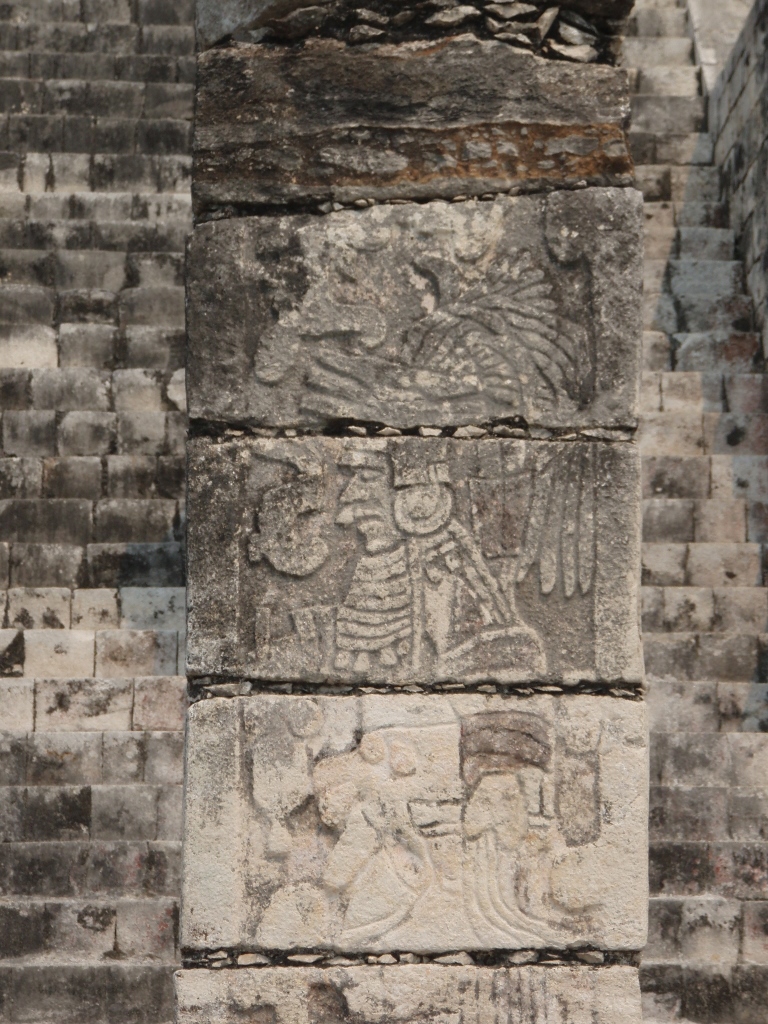 Temple of the Warriors, a detail
Temple of the Warriors, a detail
Since I stayed here for a short time in order to take photos that also meant that I was out in the open for a while longer, so I felt hot again. That’s why I moved to the shade provided by a tree for a few minutes and from there I had a lovely view at El Castillo, the central pyramid in Chichén Itzá. As I’ve already mentioned the climbing, i.e., the prohibition of climbing to some of the larger structures, El Castillo being included, let me say that, as far as I’ve heard, a few years before my visit here a woman fell to her death on El Castillo and after that any further climbing has been forbidden.
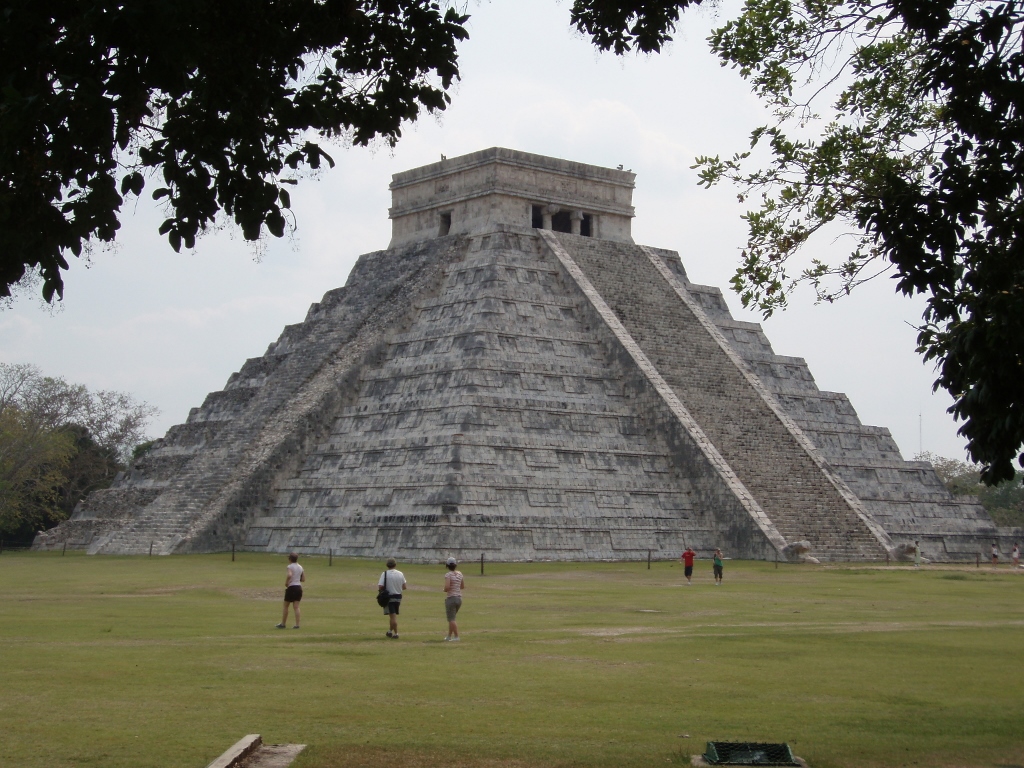 El Castillo
El Castillo